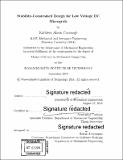| dc.contributor.advisor | Konstantin Turitsyn. | en_US |
| dc.contributor.author | Cavanagh, Kathleen Alison | en_US |
| dc.contributor.other | Massachusetts Institute of Technology. Department of Mechanical Engineering. | en_US |
| dc.date.accessioned | 2019-02-05T15:59:59Z | |
| dc.date.available | 2019-02-05T15:59:59Z | |
| dc.date.copyright | 2018 | en_US |
| dc.date.issued | 2018 | en_US |
| dc.identifier.uri | http://hdl.handle.net/1721.1/120235 | |
| dc.description | Thesis: S.M., Massachusetts Institute of Technology, Department of Mechanical Engineering, 2018. | en_US |
| dc.description | Cataloged from PDF version of thesis. | en_US |
| dc.description | Includes bibliographical references (pages 91-93). | en_US |
| dc.description.abstract | Microgrids are a promising solution to reducing the energy access gap. However, microgrids are inherently fragile systems as they are not globally stable. This thesis considers two voltage instabilities that can arise in DC microgrids as a result of tightly controlled loads in the presence of inductive delays. First, we examine the instability that arises when a constant power load is added to or removed from a network where the topology is unknown. While removing the dependence of the stability certificate on the interconnection structure creates a major technical challenge, it is beneficial as it allows for ease in network modification as the needs of a community vary. We thus develop conditions on individual power sources and loads such that a network comprised of many arbitrarily-connected units will be stable. We use Brayton-Moser potential theory to develop design constraints on individual microgrid components that certify transient stability-guaranteeing that the system will return to a suitable equilibrium after a change to the overall network loading. We find that stability can be guaranteed by installing a parallel capacitor at each constant power load, and we derive an expression for the required capacitance. Second, we analyze the small-signal instabilities in microgrids containing arbitrary, rather than constant power, loads. This network representation allows for a more accurate representation of DC loads controlled by power converters which have a destabilizing negative incremental impedance over a finite frequency band in contrast to constant power loads which have a negative incremental impedance over all frequencies. While there are many established methods for the small-signal stability certification of DC networks, these methods do not explicitly account for the influence of network. In contrast, we develop a method for stability assessment of arbitrary DC grids by introducing the Augmented Power Dissipation and showing that it's positive definiteness is a sufficient condition for stability. We present an explicit expression for this quantity through load and network impedances and show how it could be directly used for stability certification of complex networks. | en_US |
| dc.description.statementofresponsibility | by Kathleen Alison Cavanagh. | en_US |
| dc.format.extent | 93 pages | en_US |
| dc.language.iso | eng | en_US |
| dc.publisher | Massachusetts Institute of Technology | en_US |
| dc.rights | MIT theses are protected by copyright. They may be viewed, downloaded, or printed from this source but further reproduction or distribution in any format is prohibited without written permission. | en_US |
| dc.rights.uri | http://dspace.mit.edu/handle/1721.1/7582 | en_US |
| dc.subject | Mechanical Engineering. | en_US |
| dc.title | Stability-constrained design for low voltage DC microgrids | en_US |
| dc.type | Thesis | en_US |
| dc.description.degree | S.M. | en_US |
| dc.contributor.department | Massachusetts Institute of Technology. Department of Mechanical Engineering | |
| dc.identifier.oclc | 1083125628 | en_US |
